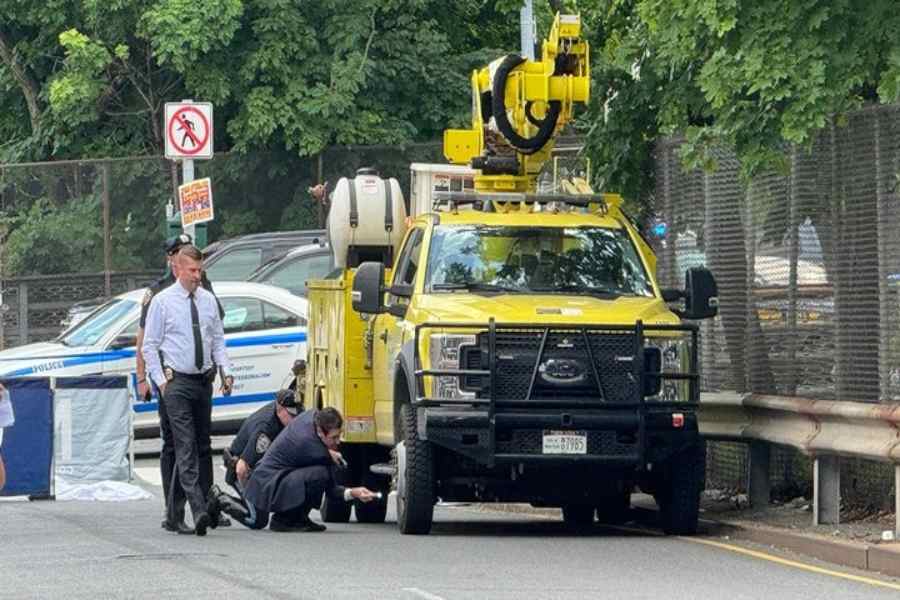
On a seemingly ordinary day that quickly turned tragic in Brooklyn, the vibrant and complex life of 86-year-old Antonio Conigliaro, affectionately known to many as ‘Tony Cakes,’ was abruptly cut short.
The events unfolded on June 12th when Conigliaro, while crossing Dahlgren Place, was tragically struck by a city Department of Transportation truck. This catastrophic collision led to his accidental decapitation.
This horrific end resonated deeply within the community. This shocking incident not only marked the demise of a man who had evolved from a notorious mobster into a cherished community figure but also underscored the unpredictable fragility of life.
Over the decades, Conigliaro’s transformation from a feared member of the Genovese crime family to a beloved local dessert vendor made him a well-known and respected figure in his neighborhood.
His sudden death, therefore, closed the final chapter of a life that had navigated through the darkest corners of organized crime to the more redemptive path of community contribution and personal reform.
A Notorious Past
Antonio Conigliaro’s early life was marked by his involvement with the Genovese crime family, one of the notorious Five Families that dominated organized crime across New York City.
Known within mob circles as ‘Tony the Dessert Man,’ Conigliaro’s role evolved from a soldier to an acting capo, engaging in activities ranging from loan sharking to racketeering.
His criminal career included various arrests, notably a 1999 criminal usury case and a 2006 grand larceny case, reflecting the darker chapters of his life.
In 2005, federal prosecutors charged him in a significant racketeering case, underlining his deep ties to organized crime. Despite this, Conigliaro served a relatively short sentence of 13 months, after which he emerged into a very different life trajectory.
Transformation and Redemption
Following his release, Conigliaro ventured into the wholesale cake and dessert business, selling sweets across New York City and running a stand in Little Italy. This marked a dramatic turn from his previous life, showcasing his transformation ability. He became known for his Italian ice and gelato and for being a generous and kind-hearted individual who endeavored to give back to the community he once exploited.
Neighbors and friends described him as “soft-spoken” and “always trying to help people,” a stark contrast to his former life in the mafia. Mathew Mari, a long-time mob lawyer and friend, noted that Conigliaro had successfully reinvented himself as ‘Tony the Dessert Man,’ becoming a cherished local figure.
The Incident and Its Aftermath
The tragic death of Antonio Conigliaro underscores pressing issues of urban safety and highlights the urgent need for heightened pedestrian awareness. This incident unfolded when Conigliaro crossed against a ‘don’t walk’ signal in a fatal lapse of judgment.
The 31-year-old truck driver involved, who was turning on a green light, struck Conigliaro, leading to immediate and devastating consequences. The driver was visibly shaken, remaining at the accident scene, and later seen praying, deeply affected by the gravity of the situation.
This heartrending event spotlights the inherent risks pedestrians face in bustling urban settings and the responsibilities of drivers in navigating these environments.
It poignantly reminds us of the critical need for stringent traffic safety measures and more comprehensive educational initiatives for drivers and pedestrians.
The local government and community leaders are now prompted to re-evaluate and possibly overhaul existing traffic safety protocols.
There is a compelling call for implementing advanced traffic control systems, enhanced pedestrian crossing signals, and broader public awareness campaigns emphasizing vigilance and adherence to traffic laws.
These measures are essential to forge a safer urban environment and prevent future tragedies of this nature.
Community Reaction and Legacy
The community’s response was one of mourning and reflection. A small memorial was quickly set up at the site of the accident, with neighbors expressing their shock and sadness over the loss of a man they respected and admired, irrespective of his past. The Genovese family, to which Conigliaro once belonged, remains a significant part of New York’s criminal history. Still, for those who knew Conigliaro in his later years, it was his transformation that they would remember.
The legacy of Antonio Conigliaro is a testament to the complex nature of human redemption and transformation. His life story serves as a narrative of change, highlighting the possibility of personal renewal and the impact one individual can have on his community, for better or worse.
Broader Implications
The story of ‘Tony Cakes also underscores the ongoing challenges of combating organized crime in New York City. While the mob’s heyday may have passed, the remnants of these criminal networks still influence certain aspects of city life.
Conigliaro’s story bridges the gap between this shadowy past and a more hopeful, if not entirely unblemished, present.
Moreover, this incident serves as a reminder of the fragility of life and the importance of community support systems in providing individuals with a chance at redemption. It raises critical questions about societal responsibilities in reintegrating former criminals and offering them opportunities to reform.
Antonio Conigliaro’s death was as dramatic as his life. His journey from a feared mobster to a beloved local businessman encapsulates themes of redemption, organized crime’s impacts, and urban living challenges.
While his death was tragic, the legacy he leaves behind in the Brooklyn community—and the broader narrative of his life—offers a compelling story of transformation and the enduring human capacity for change.








